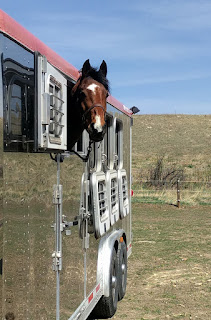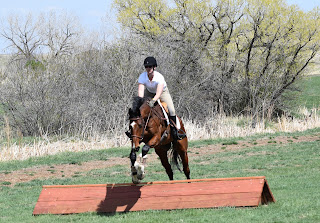What if your horse could tell you from the very beginning whether the saddle and tack were right? Surely the horse knows whether it hurts as soon as you put the saddle on, just like you know as soon as you put on a pair of ill fitting shoes. Sometimes it takes a quick walk around the store to confirm a bad fit, but it certainly doesn't take years of foot pain to determine that your shoes hurt.
Over the years I've met many horses with saddle and tack fitting problems. The first horse I had who insisted I learn what I was doing with saddle fit was Thai, a 17.1 hand OTTB with high withers and a wide, long back. He got me into saddle fitting because he was SO particular. To express his opinion, if a saddle wasn't EXACTLY right he would buck until the saddle came off. I suspect this is why no one had ever owned him for more than a year before I bought him at age ten. I quickly learned to lunge him with a new saddle before I got on to test ride it, and I found out exactly how far it was to the ground from that height many times. Once I got the saddle right, however, he was a truly incredible ride, jumping 4'6" courses like they were nothing.
 |
| Thai, the OTTB that got me started with saddle fitting |
How do I know if the horse says no? Here are several ways that horses have communicated this to me, and ways your horse might be trying to tell you that things aren't exactly right:
1 - Tensing up when you place the saddle on his back.
Especially if the horse has been ridden in the ill-fitting saddle before, he knows that one hurts. I've met some stoic quarter horses who don't say ANYTHING about the saddle hurting, other than to tense up a little when it's placed on his back.
2 - Making faces at you when grooming or tacking up, "cinchy" or "girthy"
Sometimes if the horse thinks you weren't paying attention when he told you by tensing up, he will make faces at you when tacking. Sometimes he will just raise his head high in the air. Other more obvious signs are pinned ears and biting the air (or you) when you set the saddle on his back or try to girth it up. These are hallmarks of "This saddle hurts me". I VERY rarely find a horse who is girthy just to be contrary. Those behaviors almost always indicate something hurts, whether it's the saddle, pad, girth, or he has a belly ache because of ulcers or parasites.
3 - Wiggling around when you place the saddle on his back
People often mistake this for disobedience and then focus on teaching the horse to stand still, when most of the time the horse is trying to escape something that hurts.
4 - Won't stand still for mounting
This is another one that gets mistaken for disobedience. While it's true that a horse should be taught to stand quietly for mounting, if he really insists he CAN'T by always moving away from you I get suspicious of saddle fit. When the rider puts weight in one stirrup to get on, it yanks the saddle to one side and can be dramatically painful to have a pressure point exaggerated by the weight of the rider entirely on one side. A mounting block can alleviate some of this, which is why I always insist riders use one even when the saddle is a great fit. Though the fact remains - if the saddle hurts, putting strong pressure on only one side of it is going to hurt, and your horse is trying to escape that pain.
5 - Horse won't lift his back/won't shift his weight to his haunches/won't rock back on his hocks.
These are different ways to express the same concept, depending on what style of riding you do. Sometimes if a horse is struggling to do these things the saddle is to blame. To shift weight back on his hind end he must engage his abdominal muscles and core trunk muscles, which lifts his back. If the saddle is uncomfortable, he isn't going to want to lift his back into something that is hurting him. These can also manifest as trouble with jumping bascule, or shape of his back over jumps because he doesn't want to lift his back into the pain thus increasing it. Flying lead changes, halts, backing, and sliding stops become problematic for the same reason, he must lift his back to do a clean flying change, halt squarely, back correctly, or slide to a stop.
6 - Horse is "high headed"
This is the foil of number 5. The back comes up and the head goes down. The back goes down and the head comes up. This is another way for the horse to avoid the pain of a saddle poking him in the back. By keeping his head up, his back stays down and farther away from the painful saddle.
7 - Bucking
This is one of the loudest ways a horse can protest his ill fitting saddle. If previous efforts to get a human to listen and remove the pain haven't worked, bucking generally gets a human's attention. Often the horse won't buck from saddle fit until he starts cantering. This is along the same lines as sections 5 and 6. When a horse is cantering with any kind of impulsion, due to the pattern in which his limbs move physics dictates his back has to come up. If his back comes up and he hits something painful, instinct for a horse is to buck. It fits really well with the species' natural tendencies. If a horse is in the wild, a predator going after him will jump on his back. Survival instincts kick in and he will buck and kick to try to remove the threat. Ill fitting saddles slide right into this instinctual behavior, I'm surprised more horses don't do it!
8 - Tapping the equipment
Once horses realize that I'm trying to determine what tack they want, they start to help me out by becoming more expressive. On multiple occasions I've had a horse turn his head around and tap the part of the saddle that is pinching him with his nose, sometimes even grasping a saddle flap and trying to pull it off. I've had horses take a girth in their teeth and shake it gently while staring at me to say they wanted a different one. When I replaced the girth with one that fit better they stood completely still facing forward.
It's amazing to me how much horses will try to communicate with us humans. They generally start out subtle, and get louder with their opinions if we ignore them. If your horse is showing you any of these signs, it would definitely serve you well to have the saddle fit checked. A qualified and experienced saddle fitter will do the best job, and every good saddle fitter I know agrees that your horse is the one wearing the saddle, and so it's his opinion that matters the most.





















































